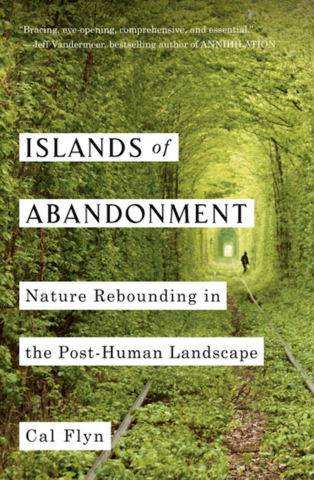
Cal Flyn's Islands of Abandonment: Nature Rebounding in the Post-Human Landscape records the breadth of her travels to sites around the world where the landscape once inhabited and exploited by human populations has been altered and become occupied by other creatures. The sites she visits include three in Scotland, her home country, three in the United States, and others in Cyprus, Estonia, the Ukraine, France, Tanzania, and Montserrat. Associations no doubt arise in readers who recognize certain locations—Chernobyl, of course, probably Detroit and the Salton Sea—and locate others on a mental world atlas with less concrete assumptions of what might be abandoned there.
Flyn spent two years researching and exploring these places and in each chapter we learn what once was there and what is no longer there and what, if anything, occupies it now. The book's Invocation, set on Inchkeith, an island in the Firth of Forth, was formerly a fortress isle with a centuries-old political history and now, "fallen into obscurity, it has risen in environmental significance." Once only nested on by eiders, it is now a breeding ground for a dozen more species and intermittently visited by countless others. When she steps out onto "what once was a gun turret" she sees "the birds rise up as one great moving, wheeling mass [. . .] outraged to see me—here, now, on this island of abandonment."
She warns readers that she will be visiting "some of the eeriest and most desolate places on Earth. A no man's land between razor-wire fences where passenger jets rust on the runway after four decades of neglect. A clearing in the woods so poisoned with arsenic that no trees can grow there. An exclusion zone thrown up around the smouldering ruin of a nuclear reactor." These and others are abandoned places, each "left to its own device," where "nature has been allowed to work unfettered." She believes they offer "invaluable insight into the wisdom of environments in flux."
I dog-eared a great many pages in the book, consulting them later to see connections. In each chapter she anchors her reflections on the past and the likely future of a locale in an observant and vivid narrative of personal exploration at the present site. In Detroit she enters and surveys an abandoned but easily accessible church and its adjacent deserted school before describing Detroit as "a city shrunk from its shell [. . .] in terminal decline for seventy years, its population reduced by almost two-thirds." She explains, "What that means, in practice, is that to drive through the city is to spin through streets and sometimes whole neighborhoods in a state of what looks like decomposition. Tens of thousands of homes stand empty and falling apart, shingles melting from roofs like hot icing, [. . .] sharp-edged gaps where rotten buildings have been pulled like teeth."
In contrast, she reports staying overnight in the deserted Rose Cottage on the Scottish island of Swona, where decades ago people about to abandon the island opened fence gates to let cattle run free, allowing creatures that had long been domesticated to begin leading feral lives. Flyn notes that here, the "process we call natural selection is coming back into play." All the rabbits on Swona, "initially black and white [. . .] now appear brown, like their wild forebears." She continually wrestles with understanding what the aftermath of industrial abandonment and military devastation and climate change mean in terms of what will replace everything that, inevitably, has been and will be lost.
Extinction has happened—repeatedly—throughout the history of Earth; after all, that's how we got here, as an adjustment, an accidental replacement for what was eliminated by a meteoric collision or a change in climate and atmosphere. One of her visits takes her to the ash-coated remains of Plymouth on the volcanic Caribbean island Montserrat where the landscape is reminiscent of Pompeii or Krakatoa or the supervolcano believed to have triggered the Permian extinction of 252 million years ago that eradicated "more than 95 percent of marine species and three-quarters of land species [. . .] leaving a vacuum in which dinosaurs would later come to the fore."
In the end she tries to consider the present planet reasonably. If the planet, "with its warming climate, has mass extinction ahead," she reminds us, "Every major extinction event on the planet has been succeeded by a burst of evolutionary creativity: rapid diversification as heretofore insignificant species take on the roles left empty by those wiped out by meteor or climate change or supervolcano." Her book asks us to consider that inevitability and hopes that, by seeing change in our own islands of abandonment, we will endeavor to resist it, delay it, be active in slowing it down.
Note: Cal Flyn. Islands of Abandonment: Nature Rebounding in the Post-Human Landscape. New York: Viking, 2021.